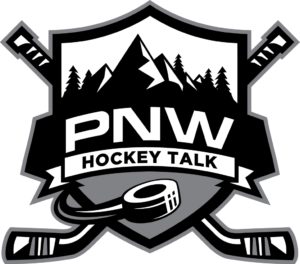
Where do all these high-end WHL players come from? How does my team know which player to draft? How are decisions made on who to select when the draft rolls around?
All of these questions can be answered by getting to know some of the least visible members of the hockey operations side of an organization.
For the Portland Winterhawks, allow me to introduce you to Jeff Pilacinski.
Pilacinski is the Winterhawks Minnesota regional scout, and has been since October 2019.
WHL scouts are some of the hardest working men and women in the hockey world. They are constantly in different local, small rinks many people have never heard of before.
I traveled to Minnesota and spent “A Day in the Life of a WHL Scout” one frigid Saturday in February.
Rise and Shine
Jeff’s morning starts with a 7:00 AM alarm so he can assist his kids with breakfast and get them ready for their game. He will soon be at the first of five hockey rinks on Saturday.
When his kid’s game is over, the attention turns to the players on his list to scout for the Winterhawks. Pilacinski is checking his pages and pages of notes on prospects he’s seen, who he hasn’t seen yet, and where some of the top prospects are playing today.
His decision on this particular day is to see two bantam games.
The first stop is to see Shattuck St. Mary’s, a private school where many top hockey players enroll to further develop their hockey skills. He arrives there a little before 1:00 and the game is completed about 90 minutes later.
He then makes the 55 minute drive north to the Eden Prairie Community Center, his third rink so far on the day. There, two of the top Bantam AA programs in the state are set to face off in battle for playoff seeding.
Longtime rivals Edina and Eden Prairie take the ice for warmups just as Jeff arrives.
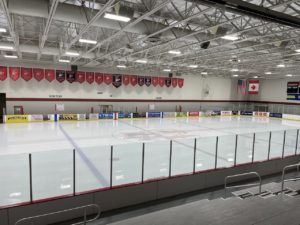
Pilacinski enjoys watching warmups as scouts can learn a lot about a player’s attitude, preparation, and how he fits in with his teammates.
“I get to see the leadership players have on the ice,” he said. “Are they leading stretching, warmup drills, or picking up pucks? If a player takes the time to pick up pucks you can see they aren’t filled with pride. I’m also looking at body language. Do they take warmups seriously? It shows how a player prepares for a game both physically and mentally. I use warmups as a little glimpse into what these players are all about. You only have so many windows to learn about these players and this is one I like to take advantage of to learn more about them.”
The game takes place in the middle of February and Jeff knows about this game due to the work he’s put in earlier in the season. He’s at so many rinks, and has talked with so many different people, he knows where the talent is within his territory.
Several of the top eligible prospects for the upcoming WHL drafts are playing in this game, yet Pilacinski is the only WHL scout in attendance.
Winterhawks director of scouting and assistant to the general manager Mike Coflin said, “The comment we get a lot back here in Portland is ‘We see Jeff at every game, at every arena, we see Portland represented way more than most WHL teams on a regular basis.’ People respect him for that and are willing to give him time because of that.”
By having conversations with parents, coaches, and others within the local hockey associations, Jeff learned a younger, talented player is appearing in the game, someone worth watching who isn’t eligible until the next WHL draft.
The amount of research Pilacinski puts into his scouting is unmatched.
“I enjoy putting in the time and effort required to do this job successfully,” he said. “Portland has always done such a tremendous job in this region and I will keep that going.”
More often than not, information about bantam hockey is not available for public consumption; he finds it on his own through hard work.
As the game gets underway I observe Jeff as he watches the game differently than I do as a reporter. He has his eyes on a couple of players, and while he’s watching the entire game, the play of the individual players on his list is more important.
During stoppages the note taking is fast and furious. There are no media timeouts or replays to watch at the Bantam level.
Later he will use his notes to help complete scouting reports to turn into Coflin.
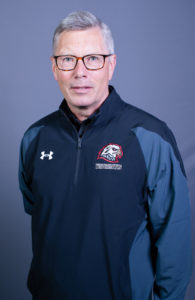
“For us to be successful as an organization, the criteria doesn’t change no matter where you see a player,” Coflin said. “Whether it is myself being in Saskatchewan at an event or Jeff in Minnesota scouting a Bantam game, we are looking for the same qualities, and rating them. We use a NHL-based rating system that is unique to Portland. We are looking for certain characteristics. The reason we do that is for consistency so that regardless where that player is seen, he is being measured on the same things. It allows us to compare and eventually sort it out to see who becomes your top targets for players.”
When the final horn sounds, Pilacinski debriefs what he saw, what he liked, what he didn’t, made a note on who he wants to see again, and others where he feels his notebook can be closed for this scouting cycle.
The focus for the day turns to taking the 20-30 minute drive north to get to the fourth rink of the day.
The challenge of the Western Hockey League in Minnesota
Minnesota is one of the top states in producing high-end hockey players, but the culture there screams for one, maybe two paths.
For a long time the mentality is a player stays home and plays with the same team all the way through his senior season and he graduates high school from the same program.
With the rise of junior hockey, more and more players are starting to take advantage and leave before they graduate. However, should a player choose to deviate from that path, many in the community still firmly believe it should be for the USHL or United States National Development Program. The concept of going to the WHL is almost unheard of in most cities.
This is where Jeff really gets involved and helps educate players, parents, and family advisors.
He also sifts through the players and families who want nothing to do with the league. The benefit of Minnesota is the number of players, and the number of talented ones as well.
As Pilacinski gets to know if a player has interest in Portland, he will start to build the relationship with the family and player.
“My situation in this region is unique and is about 60% watching games and 40% educating and building relationships with families,” Pilacinski said. “I have to do a lot more of the educating than some of our other scouts in Western Canada. A lot of the players and families in Minnesota don’t have the same understanding of the WHL. So many players here are constantly exposed to only one path, high school hockey, maybe USHL after they graduate, and then off to Division One college hockey. My job is to make sure families know about alternative paths which may be beneficial for them. I pride myself in being honest about the two different paths and not bashing the NCAA path. It is a good path, but it isn’t for every player, nor is it the only option available to them.”
While the ultimate goal is for Portland to sign these prospects, the hope from the organization is to have the player at least come to a training camp to see what the Winterhawks are all about.
Coflin gives Pilacinski a ton of credit given how different his region is compared to other scouts on his staff.
“In Minnesota there is such a high-level of players but they are mixed within the nature of high school hockey. There are many different levels or divisions, A or AA, there are elite teams, teams that aren’t in an elite league. You have to be able to sort through a lot of hockey. You might find the best player for our program in a game that is not the best hockey game or on the best team,” Coflin said.
An example is Carsen Musser who Jeff identified two draft cycles ago.
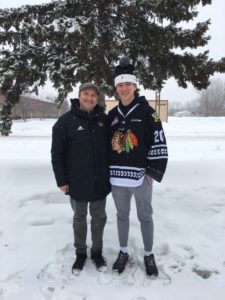
“Musser was in grade nine as a starting goalie for his team losing almost every game while facing 60 or 70 shots a night. He was playing in the middle of nowhere, but we did see him and identify him, we were able to draft him. Turns out, that is where the best goalie prospect was last year,” Coflin said. “Other times you are drawn to the hotbed of hockey in the markets of Eden Prairie, Edina, and Chaska; it is pretty easy to watch a good game there. There are NHL-level draft picks on those teams, but potentially those are players that won’t come here. We have to identify which are likely to come our way.”
Breaking into the scouting world
Before we departed Eden Prairie’s rink for our next stop in St. Louis Park, Pilacinski shared the unique story of how he got into scouting for the Winterhawks.
His passion for the game and spotting talented players was always there, but he wanted more. He wanted inside an organization.
“I come from a non-traditional path,” Pilacinski shared. “I didn’t play the game at a super high level or have any direct contacts with a general manager or someone on the hockey operations side. I came across an article about a punk rock singer who got into scouting for the WHL and my love for the game got rekindled when my kids started playing. I felt if I applied myself I could at least explore what was out there and take that step. I told myself, ‘You know what, I have a deep, deep urge to keep learning and working hard.’ So I sought out a program called SMWW, Sports Management Worldwide.”
During his time in the program which helps individuals learn more about the general managing, hockey operations, and scouting side of the hockey industry, Pilacinski connected with longtime Boston Bruins scout Mike McGraw.
“I mentioned to him that I wanted to work in junior hockey as it would be a good place for me to start, and he was very generous with his time. He suggested I not sell myself short, and that I consider the Western Hockey League. I did some research on my own and came across Mike Coflin’s name with the Winterhawks. I sent him an email thinking ‘No way this guy responds, right?’ Sure enough he got back to me. We talked for almost two hours. I’m so thankful for how generous he was with his time since he didn’t even really know who I was.”
What happened next for Pilacinski felt like a dream.
Coflin asked him if he was around the following weekend, as Eric Doyle, Portland’s head US scout at the time, was going to be in Minnesota for a tournament and the two should meet.
Sure enough, the two watched several 14U and 15U games that weekend. The two exchanged perspectives on scouting and what they were looking for in a player.
As the weekend came to a close, Eric pulled Jeff aside and said, “Before you go, why don’t you write a couple of short scouting reports on players you saw with me. Also, Mike (Coflin) is going to be in town next weekend for another tournament. I think you should stop by and meet with him face to face.”
Coflin made his way east from his home in British Columbia to the land of 10,000 lakes and watched a tournament with Pilacinski.
Pilacinski, Coflin, and Doyle watched the showcase together and at the conclusion, Jeff’s dream became a reality.
“Mike pulled me aside to say, “What would you think about working for the Winterhawks as our Minnesota regional scout?’ I tried to be as humble as possible but said, ‘I would be honored to work for the Winterhawks and grateful for the opportunity.’ I was holding back tears of joy and thinking, ‘You can’t cry in front of this guy’ but of course I said yes. They took a chance on me, and I’m extremely grateful. We all shook hands, smiled, walked away, and then got to work. I knew I had big shoes to fill as Josh Dye and Eric Fink (former Winterhawks scouts who were hired by NHL teams) had done tremendous work in this area, but I was ready to put in the work and energy needed.”
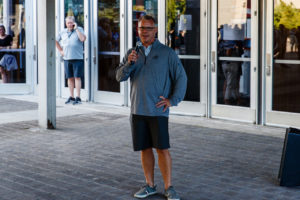
Coflin emphasized the feeling is mutual. “WHL hockey is not first and foremost in the minds of many people in Minnesota. Traditionally high school hockey leads to the NCAA college route. To have a person who accepts that challenge, puts the work in, largely educating players, families, advisors about what Portland is all about and what Portland has to offer is really significant. A scout for a Western Hockey League team in Minnesota is one of the most challenging positions we have and we wouldn’t have a chance with any of these prospects without Jeff’s presence there. So we are thankful that Jeff gets into rinks and is building those relationships. He’s done an excellent job and the last two drafts would demonstrate that.”
Keeping up with current prospects
The fourth rink Pilacinski visits is the St. Louis Park Rec Center where the Chaska Hawks are set to battle conference rival Benilde-St. Margret’s, a top-ten team in the state.
Throughout the year Pilacinski keeps in contact with previously drafted players who are still in Minnesota. On this night, with two drafted prospects on Chaska, the opportunity is to see how Tanner Bruender and Adam Kleber play against some of the best competition in the state.
We arrive approximately 45 minutes prior to puck drop so Pilacinski can make his rounds. On this particular night there are over a dozen NHL scouts in the building to watch a defenseman on Chaska.
The goal remains the same though; the pomp and circumstance around this game does not mean as much to Pilacinski. His mission is to connect with the families and see how the Portland-drafted prospects handle the situation.
Both the Bruenders and Klebers chat with Pilacinski and me for several minutes to get an update on how their season has been going.
The importance of maintaining contact with the parents is one of the areas Pilacinski takes the most pride.
“I enjoy getting to speak with the parents throughout the year to continue to educate them and about what their son’s future would be like in Portland. I also get to hear about what’s important to them and what their values are,” Pilacinski said.
The student sections begins to fill in and the national anthem is about to be played so we take our seats to get a first-hand look at Bruender and Kleber.
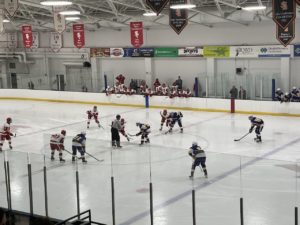
Jeff once again breaks out the padfolio to take his notes. Our conversation throughout the game is less about the play but more focused on the skills and traits we are seeing out of the two Winterhawks prospects.
Portland sees a high ceiling for Bruender and Kleber, but unfortunately their minutes were reduced in favor of older players. However, when they are on the ice, both are noticeable every shift.
Kleber picked up an assist from his blue line position on the game-winning goal and Bruender did not leave the ice in the final 2:36 as his team protected a one-goal lead.
All throughout the game Pilacinski would make a comment or note “Player X did this well, Player Y sacrificed the body, his stick positioning on the PK is right where it is supposed to be, if Player Z can improve his first three strides look out.”
All day Pilacinski was not focused on the game as a whole, but instead the skill sets for those players eligible for the draft or being listed to the Winterhawks protected list.
When the final horn sounded shortly before 9:15 PM the night was still young for Pilacinski
One more rink…
After a great day watching hockey, Pilacinski had one more rink to attend.
He made the trip south to the legendary Braemar Arena in Edina. This time though, there was a little less stress. Also, the players in this game have aged-out of WHL eligibility a long time ago.
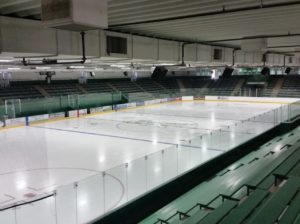
Now, it was time for Pilacinski to strap on the pads himself.
By 9:30 Jeff and his teammates were competing in a game of adult hockey where Pilacinski scored a goal and an assist to help lead his team to a 6-2 victory.
After laughing with the guys following the game, Pilacinski drove home and pulled into the driveway around midnight.
He then prepared to do it all over again the next day as there were more scouting reports to complete.
Final Thoughts
While Pilacinski is in rinks as often as he can, scouting for the Winterhawks isn’t his full time job. He works for the University of Minnesota Medical School in its admissions department.
Jeff’s determination to pursue his passions started long before he got into the hockey world.
When he was younger, Pilacinski had the opportunity to travel internationally for one of his other passions: archaeology. He had stops in Turkey, Egypt, Cyprus, and Israel, where he participated in an excavation near the Lebanese border.
Pilacinski is not where he is today, or able to put in the needed time and energy scouting, without the support of his wife and two kids.
“There is a lot of time away in rinks and writing reports. I can be gone a lot, but I want to make sure I’m still very much present and engaged in my family life,” he said. “It was a big step for me as I also have my full-time job that pays the bills – I’m doing this because it is my passion, not for the money. My family encourages me every step of the way to live out my dream. My wife and kids are my rock, I’m so thankful to them, and I couldn’t do this without their unwavering support.”
Scouting and balancing home life is something Coflin is well aware of with his scouts. Striking that balance is important to him.
“This is not their full-time job, so it is people who have lives, families, and work to take care of. They are then helping us because of their passion for hockey on the side. We have to be aware of that. There may be times where those other priorities will take the place of scouting hockey,” Coflin said. “We are really careful in terms of any demands we would put on them. They schedule themselves, but we identify priority tournaments and events for them where they are likely to see the best players. We try to put them in contact with players or family advisors as well.”
The dedication and passion Pilacinski has for scouting is not lost on Coflin.
“Jeff watches a lot of games without knowing the payoff. It won’t always be obvious when a player is going to come along that said player comes to Portland. He needs to have a real resilience to it. He goes through the steps and he doesn’t skip any part of the education process, dealing with all the misinformation, keeping his calm, cool, and focus on the long term goal. If we do the right things, and represent our organization the right way, we can get some players that we are better fit for than some of the ‘traditional Minnesota options’. Jeff has done that really well the last two years,” Coflin said.
Jeff gives credit to Eric Doyle for taking him under his wing and showing what it means to be a WHL scout.
“Eric took a chance on me, believed in me, and I’m very grateful for his friendship,” Pilacinski said. “He has a deep knowledge of the game and was always willing to share insights with me.”
The ability to continue to learn and be involved in a professionally-run organization is what Pilacinski finds most rewarding.
“I get to work around great hockey minds in Mike Johnston and Mike Coflin and do so at a really high level,” he said. “I’ve been able to build really strong, honest relationships with families in this area. It is incredible to watch these players and see where they’ve started and see how their career moves forward. I’m a small piece to the process and Winterhawks organization, but I’m thankful I get to contribute to a really successful organization.”

